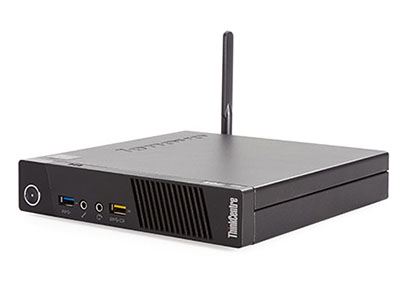Tom's Guide Verdict
While larger than other mini PCs, the M83 Tiny is a powerful desktop for home and business, with an optional all-in-one monitor accessory.
Pros
- +
Desktop-class CPU
- +
Lots of ports
- +
Highly configurable
- +
Seamless integration with 23-inch monitor
Cons
- -
Large for a mini PC
- -
Internals hard to access
Why you can trust Tom's Guide
Whether you're building a kiosk, setting up a point-of-sale system or just trying to conserve space in your office or home, Lenovo's ThinkCentre M83 Tiny offers desktop-class performance and flexibility in a package the size of a hardcover book. You can even attach Lenovo's mini PC to the back of a VESA-equipped display or one of Lenovo's monitor/dock combos to make a DIY all-in-one of sorts. With two models, starting at $483 and $694, and lots of configurable options, the M83 Tiny doesn't cost much more than a floor-hogging tower, saving you room without sacrificing performance or ports.
Design
With a focus on business first, the M83's humble design wasn't made to attract attention. Instead, this mini PC does a good job of hiding in the background, featuring a no-frills, matte-black case made from sturdy steel. The front features an angled grille and another fan vent in the back that works with Lenovo's Intelligent Cooling Engine (ICE) 3.0 to provide an ideal balance between cooling and quiet operation.
At 7.2 x 7 x 1.35 inches and 2.6 pounds, the M83 is significantly larger and heavier than Intel's NUC (4.5 x 4.4 x 1.3 inches and 1 pound) but a tad smaller than the Mac mini (7.7 x 7.7 x 1.4 inches and 2.6 pounds). When compared to a $639 Lenovo M83 Mini Tower Desktop with similar specs (17.4 x 16.3 x 6.9 inches and 24.3 pounds), the M83 Tiny weighs nine times less and takes up almost 30 times less space, without much difference in price.
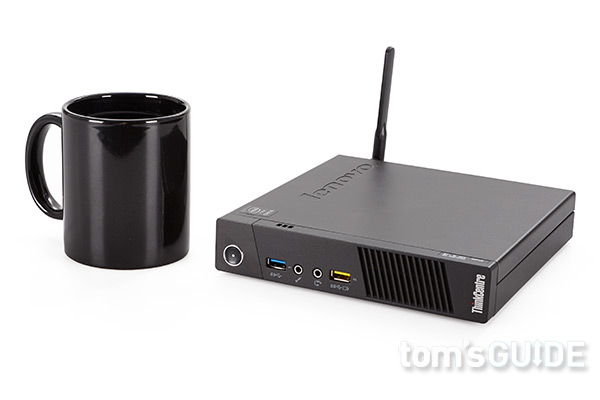
While not as petite as Intel's NUC or Gigabyte's Brix, the M83 Tiny is more than small enough to easily disappear behind a display — and with support for standard VESA mounts, it's not hard to make that happen. For business users, Lenovo also touts its partnership with Intel's Stable Image Platform Program, which promises stable drivers and availability of extra components for 15 months.
My only complaint about the M83's design is that the internals are hard to access, with tightly cramped corners that require a special tool to open. Intel's NUC is much easier to service, requiring just a simple Phillips-head screwdriver to get access to the internals. To get an M83 that's easier to upgrade, you'll have to move up to the M83 Pro (for about $100 more), which features tool-less expansion capabilities.
Ports and Connectivity
By making the M83 larger than some other mini PCs, Lenovo has left plenty of room for ports. The M83's chassis packs two USB 3.0 Ports up front (one with always-on charging), as well as flanking jacks for a microphone and headset. Around the back, the M83 has three additional USB 3.0 ports, two full-size DisplayPorts, a VGA port, an Ethernet jack and a Kensington lock slot.
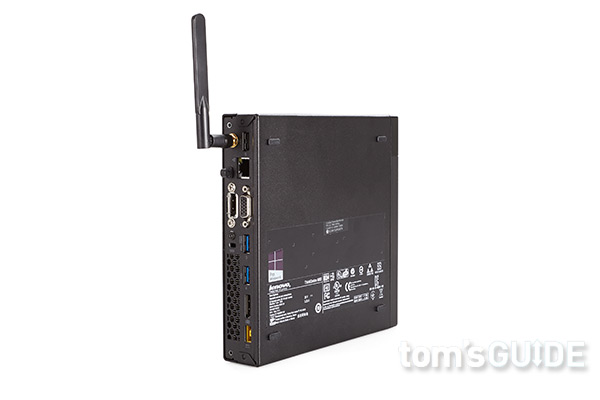
This gives the M83 out-of-the-box support for up to three displays, without requiring a splitter or a dock. The Mac mini fares a bit better, with one HDMI port and two Thunderbolt ports, but the Mac mini has a total of four USB 3.0 ports, compared with five on the M83. (The NUC also tops out at four USB ports.)
The M83 also comes with Intel's Dual Band 7260 AC wireless card, which includes support for Bluetooth 4.0, Intel Wireless Display and Wi-Fi speeds up to 867 Mbps.
MORE: Best All-in-One PCs
Performance
While smaller mini PCs like the Intel NUC use low-power, mobile processors, the ThinkCentre M83 Tiny has room and adequate cooling for a desktop-class CPU. With a 2-GHz Intel Core i5-4590T CPU, 8GB of RAM and a 500GB, 7,200-rpm hard drive, the M83 easily handles typical business computing needs, such as editing large spreadsheets, opening multiple browser tabs and watching high-definition videos. Even when I streamed two 1080p movies from YouTube at the same time, there wasn't a hint of stutter or lag.
To test overall system performance, we ran the Geekbench 3 benchmark, and the M83 scored 8,522. That's significantly faster than the Core i5-5250U-powered Intel NUC's score of 5,611; the 1.4-GHz Core i5-powered Mac mini's mark of 5,443; and the all-in-one desktop average of 7,013.
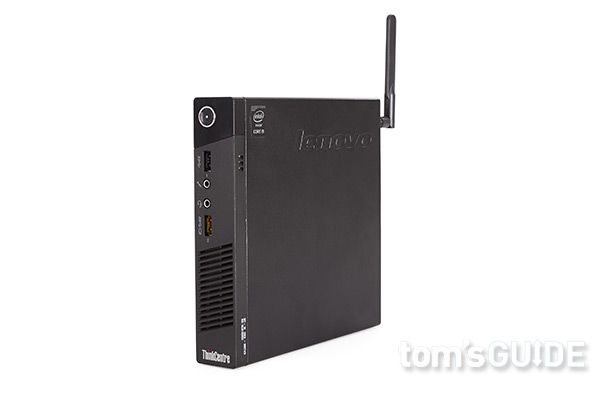
The ThinkCentre M83 Tiny finished ahead in real-world situations, too. On our spreadsheet test, which matches 20,000 names and addresses in OpenOffice, the M83 finished in 4 minutes and 31 seconds. That's 30 seconds ahead of the Intel NUC (5:02), nearly 2 minutes faster than the Mac mini (6:17), and 2 and a half minutes faster than the all-in-one average (7:00).
Unfortunately, on our transfer test, our configuration of the ThinkCentre M83 Tiny, with its old-school hard drive, couldn't keep up with systems equipped with SSDs. When we duplicated 4.97GB of mixed media files, the M83 took 2 minutes and 37 seconds to complete the transfer. Its rate of 33.3 MBps is similar to that of the Mac mini (34.4 MBps), slightly slower than the all-in-one average of 58 MBps, and far short of the Intel NUC (308.8 MBps) and its PCIe x4 SSD.
Graphics
Even though the ThinkCentre M83 Tiny is on the larger side for a mini PC, it still doesn't have enough room for discrete graphics. Instead, it relies on Intel's integrated HD 4600 GPU, which can handle media editing and some light gaming, but not much more. Even at 1920 x 1080 pixels and medium settings, casual online card game Hearthstone: Heroes of Warcraft encountered occasional bouts of lag, which caused frame rates to stutter and dip.

When playing World of Warcraft at 1920 x 1080p and auto settings, the M83 Tiny managed just 23 frames per second, short of our 30-fps playability threshold. However, the competition didn't fare much better: The NUC and the Mac mini reached 26 and 30 fps, respectively, on the same settings.
In 3DMark's Fire Strike graphics test, the M83 scored just 608. That's 40 percent lower than Intel's NUC (888), and more than 70 percent behind the all-in-one average of 1,053.
ThinkCentre Tiny-in-One 23 Accessory
When you buy an all-in-one PC, the components usually become outdated long before the display does. This means you have to jettison a perfectly good screen just to upgrade the CPU. Lenovo's $279 ThinkCentre Tiny-in-One 23 eliminates this problem, giving you a 23-inch monitor with a built-in dock that transforms the M83 into a system with all of the benefits of an all-in-one and none of its downsides.
Setup is dead simple, thanks to a custom designed enclosure on the back of the monitor that allows you to securely attach the M83 without any tools. Just drop the M83 into the opening at the top (don't forget to remove the Wi-Fi antenna first), and connect it to the display using the three-port, pass-through connector. Lenovo says future Tiny PCs will also fit in the dock, allowing you to keep the monitor through several upgrade cycles.
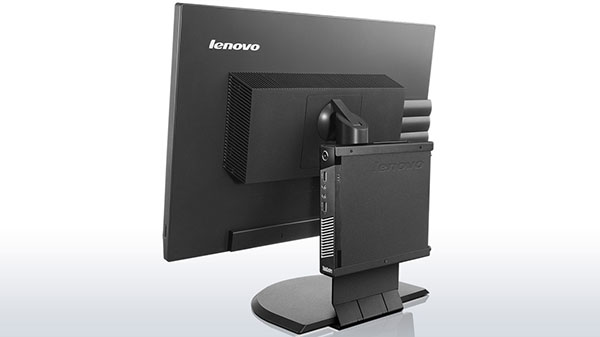
Using this monitor ups the total USB port count to six (although one is type B), while still using just a single power cord. Doors on the left and right sides provide access to the remaining ports, with the door on the left also doubling as a slot for a USB optical drive.
The screen itself is a 23-inch 1920 x 1080p TN display with a max brightness of 169 nits, although the 77-nit out-of-the-box brightness was a little dim. Based on our testing, the Lenovo monitor covers 101 percent of the sRGB color spectrum and achieved a Delta-E color-accuracy rating of 4.4 (closer to zero is best).
MORE: Best Gaming Desktops
Keyboard and Mouse
The M83 comes with a bare-bones mouse and keyboard combo. These are the kinds of basic peripherals that get tossed in every package to ensure you have something to use out of the box, but often these peripherals should be replaced as soon as possible.
The keyboard features a standard 104-key layout with 4 millimeters of key travel and a typical actuation weight of 70 grams. Typing felt mushy due to the keyboard's rubber dome switches, and the actuation weight varied up and down by 10 grams due to the variances in each individual rubber switch. However, I did like that the rubber domes have the nice side effect of making key presses almost silent. Even with the squishy keystrokes, the keyboard's familiar layout let me surpass my typical average of 75 to 80 words per minute after just a couple of attempts (with just a single error) on 10fastfingers.com.
The mouse is a simple two-button device with a red scroll wheel to remind you that it's part of Lenovo's business line. The infrared sensor works fine in most situations but doesn't have the ability to track on glass like you see on more expensive mice. Unlike the keyboard, the mouse buttons have a nice clicky actuation, although they are just a bit on the loud side.
Configurations and Warranty
Lenovo offers two starting configurations of the M83: an Intel Core i3 model with 4GB of RAM and a 500GB, 7,200-rpm HDD for $483, and an Intel Core i5 model with 8GB of RAM and a 500GB HDD for $694. Using Lenovo's online configurator, both models can be upgraded to a Core i7 processor, 16GB of RAM and a 256GB SSD. The real difference is that the i3 model comes packaged with a slim SATA DVD burner, while the i5 model features a free downgrade to Windows 7.
Every M83 comes standard with a three-year limited warranty, which includes weekday on-site service for parts and labor. This can be extended to a max of five years with 24/7 phone support, on-site service and next-day repair for $149.
Bottom Line
For business users, the combination of Lenovo's enterprise support, service and compatibility with accessories like the Tiny-in-One monitors makes the M83 Tiny a very attractive mini PC. At $649 for an Intel Core i5-4590T CPU, 8GB of RAM and a 500GB SSD, you get better performance than you'll find on a similarly priced Intel NUC or Mac mini, and if you need the extra storage speed, Lenovo offers upgrades to solid-state drives as well. The plethora of ports also makes it a cinch to attach multiple peripherals, which, when combined with its size, makes the Tiny a good choice for use as a point-of-sale device or a marquee display machine.
Tech-savvy home users or small businesses that don't need the same level of support should consider the Intel NUC ($390), which is smaller but requires you to bring your own RAM, storage and operating system. However, if you need a powerful, space-saving desktop that's ready to roar out of the box, the ThinkCentre M83 Tiny should be at the top of your list.
Sam is a Senior Writer at Engadget and previously worked at Gizmodo as a Senior Reporter. Before that, he worked at Tom's Guide and Laptop Mag as a Staff Writer and Senior Product Review Analyst, overseeing benchmarks and testing for countless product reviews. He was also an archery instructor and a penguin trainer too (really).
-
NoraaC I recently purchased this setup. A Tiny in One 23 monitor and a M83 with optical drive. The computer mounted nicely in the slot provided on the back of the monitor but the optical drive was too large to fit the housing provided for optical drives and didn't have the right connector in any case.Reply
I have to believe that there is such a thing as an optical drive that fits this TIO Monitor. The description on the Lenovo's web site states that there is a slot for an optical drive and that the TIO 23 is compatible with all of the Tiny series desktops. The manual for the monitor has quite clear and complete instructions on mounting an optical drive.
However no one on Lenovo's support staff that I spoke to including teck support, sales and customer support seemed to have any idea what I was talking about or to have any familiarity with the Tiny in One Monitor/all in one concept. Tech support was unable to locate a part that would fit, sales said "we don't have that - try a third part vendor" and customer support said "You got what you ordered if you are not happy send it back"
I'm not going to send it back because other than this issue I really like the unit, I would just like to be able to mount the optical drive on the monitor as advertised.
